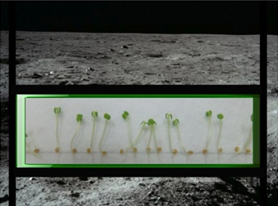NASA plans to send live plants to the moon in 2015 as part of Google’s Lunar X Prize program

As already mentioned earlier, now the space industry, space tourism and all the other "space", is developing, and quite actively. New space programs are emerging, the purpose of which is to study the near and far space, as well as to master the planets of the solar system. All of these programs consist of many stages, and one of them is the “landing” of living organisms, plants, on the surface of the moon, in 2015. And this is not a fantasy, but a very real project from NASA.
The agency cannot, unfortunately, send plants to the moon on its own right now, so NASA will cooperate on this issue with the winner of the Google Lunar X Prize program. This program, I recall, is devoted to the development of private "lunar" projects. Read more about this here . So, the winner of the program from Google, at the request of NASA, together with its lunar apparatus, will launch a kilogram cargo to the Earth’s satellite, which is a closed life support system for plants.
')

According to the plan, the plants should be unloaded on the surface of the moon (there will be three types of plants - turnip, basil and Arabidopsis). The purpose of this experiment is to check how living organisms will feel on the Moon, in conditions of high radiation background, a different gravity and in general the whole set of “lunar factors”. If everything goes well, it is likely that the person will live and work normally on the moon. Otherwise ... Well, we are all optimistic in this regard, right? Scientists hope that the plants will be able to live and multiply in the usual manner for a long time.
The results of the project can be assessed as soon as 2 weeks after planting the plants. If the plants live for 2 weeks, this will show that, in general, it is possible to live on the moon. After 60 days, if the plants feel normal, it will be safe to say that meiosis is possible in the lunar environment. After 180 days, it will be clear how radiation affects the dominant and recessive genetic traits.
Well, the longer the "space-plants" hold on, the more valuable the results will be obtained by science.
Via nasa
Source: https://habr.com/ru/post/204924/
All Articles